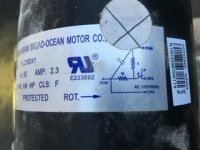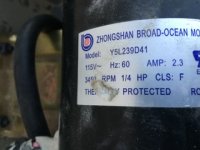Jpflex
Electrician big leagues
- Location
- Victorville
- Occupation
- Electrician commercial and residential
On a fan motor for “mr heater” Industrial 175,000 btu heater there is a wiring diagram.
On the diagram as shown I was just curious on your thoughts on its purpose. Normally they are used as start capacitors to place a phase difference between field poles, however this diagram doesn’t seem to depict this?
Other purposes could be signal filtering, power factor correction for economy. What are other thoughts?
Also how would you think thermostat Bulb and controls work? In the old school days mercury would rise in sensing bulb to close a switch when heat rose.
Do they now use a reastat or variable resistor changing values and voltage drop to Module to sense ambient temp?
On the diagram as shown I was just curious on your thoughts on its purpose. Normally they are used as start capacitors to place a phase difference between field poles, however this diagram doesn’t seem to depict this?
Other purposes could be signal filtering, power factor correction for economy. What are other thoughts?
Also how would you think thermostat Bulb and controls work? In the old school days mercury would rise in sensing bulb to close a switch when heat rose.
Do they now use a reastat or variable resistor changing values and voltage drop to Module to sense ambient temp?




